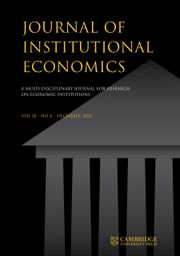No CrossRef data available.
Article contents
Polycentric governance in collusive agreements
Published online by Cambridge University Press: 15 November 2024
Abstract
Collusive agreements in the form of corporate cartels are complex structures. The involved firms need to agree on terms that are legally not enforceable. However, the interplay between the involved firms in a collusive agreement, i.e., the governance dimension within a cartel, has received surprisingly low attention. Using a comprehensive OECD dataset of 191 cartels from 2012 to 2018, this paper empirically demonstrates how polycentric governance within a cartel may possibly contribute to understanding its stability. It may be beneficial for the duration and lower sanctions imposed by competition authorities, especially for large cartels. By that, the paper sheds new light on two aspects: the entangled governance structures of corporate cartels and the relevance of the concept of polycentricity beyond public administration.
- Type
- Research Article
- Information
- Copyright
- Copyright © The Author(s), 2024. Published by Cambridge University Press on behalf of Millennium Economics Ltd.


